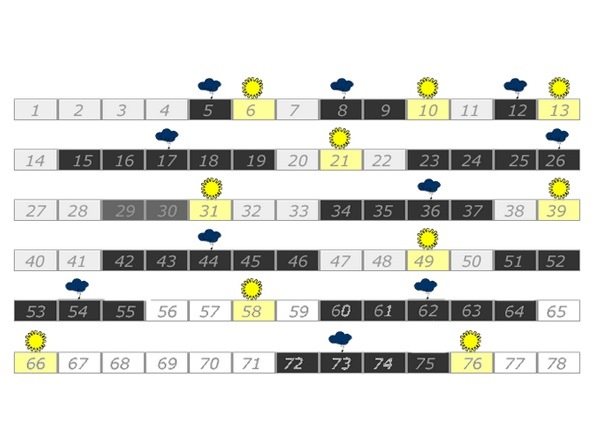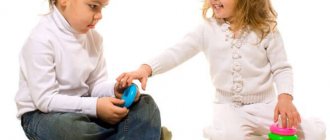Why are growth spurts called crises?
My grandfather once asked me this question. If you don’t like this word, you will soon feel that such a stage cannot be called anything other than a crisis. Kids are actually true conservatives. Therefore, every change in external conditions (change of time zones, different regime, change of weather, new place) is not easy for them.
Therefore, the child begins to show his dissatisfaction. Of course, he just got used to his feelings, to the established routine - and again nothing is clear. It’s also very difficult for him, both physically and mentally. Each growth spurt brings with it a fundamental change in the child’s worldview.
Then he begins to cry more, whine, be capricious and clutch at the saving straw - his mother. Only she has remained unchanged, only she can help, console, caress. That is why during crises the child constantly asks to be held, which causes mother’s indignation: “How? After all, he just learned to play/sleep/crawl on his own!”
Yes, this is a difficult time, both for the child and for the parents. All you need is a little patience. Life will get better soon! But only for a while...
Here's what you need to do to make sure your baby's growth spurts are as easy as possible:
- Don't forget to check your children's age crisis calendar from time to time so that the growth spurt won't take you by surprise. Forewarned is forearmed!
- Put everything aside for the duration of the crisis. Often mothers become more nervous because they begin to accomplish less, cannot cope with cleaning and cooking, or let down their bosses if the mother has to work. Show the calendar to your husband and explain that you will need more help. Don't take on extra work. And keep in mind that you won’t be able to really mind your own business for a couple of weeks.
- Pay as much attention to your child as possible. Even if (especially if) he whines and annoys you. Instead of getting angry, take your baby in your arms and sing a song, dance and kiss. Believe me, it helps! You can often notice that mom’s cheerfulness helps the crisis end much faster. Take pity on your baby and carry it in your arms (in a sling) more often. Now he urgently needs direct contact with his mother.
- Don't forget to replenish your energy! Difficult times take more strength from us, which means we need to replenish them more often in order to survive the next crisis without losses and unnecessary nerves.
- Change your surroundings. If possible, go to nature with your family, meet friends, especially if they also have children, go to playgrounds more often, meet new people and show your child the world. Many, on the contrary, lock themselves within four walls, believing that you can’t go anywhere with such a capricious child, but this is fundamentally wrong! It is very interesting outside your home, and it will distract your baby from his problems, and you will unwind - now you need this more than ever.
Here are all the secrets to recognizing growth spurts and overcoming the difficulties associated with them! Nothing complicated, right? However, there are parents who have no idea about any crises and are perplexed every time, waste their nerves, and even money on doctors, thinking that something is wrong with the child... Show this article to your friends - let them also be in the know !
Psycho-emotional development of children
The newborn spends most of his time sleeping and is hardly disturbed by sounds. Only a sharp loud sound or a bright light aimed directly at closed eyelids can wake up a child.
At 1 month, babies begin to see the world around them and use the movement of their eyeballs to track slowly moving objects.
At 2 months, children understand the sleep-wake schedule and are able to stick to it. The first emotional manifestation in response to external factors can be noticed precisely at this age.
First smile
A three-month-old baby begins to recognize his mother not only by smell, but also by appearance. The child is attracted to toys.
At 4 months, children can play independently longer if the toys are located close. The baby is not afraid to be alone and can calmly spend some time alone with bright objects.
At 5 months, children understand adults' intonation well and also recognize themselves in the mirror.
A six-month-old baby reacts to his name and tries to pronounce the first syllables.
From 7 to 8 months, the ability to distinguish between familiar people and strangers develops. Therefore, children of this age are reluctant to go to the arms of unfamiliar relatives.
At 9-10 months, children easily recognize their grandmother or mother among people and can express their joy by waving at them.
After 11 months, the child understands taboo words, which can greatly upset him. If he hears that he can't touch or do something, the frustration may become too emotional and lead to hysterics.
19 weeks
At 5 months, children experience a developmental spurt. At this age, a boy or girl acquires the following skills:
- The fidget holds her head confidently and knows how to turn it.
- Now children are making their first attempts to crawl.
- The baby pulls himself up, holding his mother’s hands.
- The child rolls over from back to stomach and back.
- The baby smiles when he sees his family and frowns when he hears a stern tone.
- At this age, he already has toys that the baby prefers.
- Movements become more confident.
- The toddler holds the toys tightly and takes them on his own.
- It stands on its legs if you support its armpits.
At five months, the baby listens attentively to the conversation of his family, he frowns at loud sounds, and smiles if you speak to him kindly. Despite the fact that each baby develops individually, he experiences a growth spurt at this age.
Frequency of growth spurts
Growth spurts in children under one year of age are periods during which parents notice significant changes in the child’s behavior and skills. It has happened to every mother that she woke up one morning and realized that today the child seemed to be replaced - he did not allow her to leave for a long time, demanded a toy or did not fit into her favorite onesie. Before each new stage of development, the body gains strength and accumulates potential, so that at some point it can surprise itself and its parents with a new skill.
During the first year of life, up to 7 developmental leaps in a child can be observed:
- Parents will encounter the first immediately after the end of the newborn period - after the 28th day of life;
- The second time the baby will change behavior and become a little different at 2 months;
- By the middle of the 3rd month there will be another net that will not go unnoticed;
- At 5 months, the mother will begin to notice that it has become more difficult to walk with the baby. This is the most difficult fourth jump. It arises because the baby already holds his head well and wants to sit up, but he still can’t, hence the glaring crisis;
- The fifth leap will occur immediately after the baby turns six months old;
- For the sixth time, a crisis will occur after 8 months, when the baby confidently sits down and begins to perceive the world in a vertical plane;
- The very last, seventh leap occurs when the child turns 10 months old. At this age, almost all children can stand and have already tried to take their first steps, but they still cannot walk confidently, which becomes the cause of nervous crises.
If a mother keeps a diary of the baby’s development, her notes will automatically form a calendar of the child’s developmental leaps, based on notes that on certain days the baby was especially nervous for no apparent reason.

The baby is upset
Important! Adults should not lash out at children. Increased moodiness has nothing to do with character damage. Children themselves suffer from the fact that their psyche undergoes drastic changes, so at such moments the little ones need support and care even more.
Taking it to the next level
In pediatrics, growth spurt in infants is considered as a crisis period of physiological and psychological development. Very quickly, sometimes overnight, a child can grow several millimeters. Intellectual abilities increase due to increased neural connections.
Over the course of a year, a baby experiences 8 leaps. The body needs a lot of energy to ensure the normal course of rapid development. For this reason, children under one year old sleep so much. The child experiences these periods with difficulty. He needs increased support, increased care, constant attention.
This is a new level in the development of a child. Not only does his physiological indicators increase sharply, but he also acquires other skills. All changes are related to the functioning of the brain. The duration of the changes varies from person to person, but on average lasts from 2 to 7 days.
Duration of jumps
Each period of growth in children is accompanied by activation of the brain and the entire central nervous system. Brain waves become increasingly active. All processes in the brain occur much faster. Some scientists compare the crisis stages in children with premenstrual syndrome in women.
The duration of a growth spurt in babies can last from several days to several weeks. It arises suddenly and ends unexpectedly. It is impossible to calculate exactly when this difficult period will come, since it does not have clear boundaries of beginning and end. Even today the little one won’t get off his hands, constantly demands the breast, cries for no reason, and tomorrow he will wake up his parents with a smile and fiery laughter.
Symptoms of growth spurts
Growth spurts in children under one year of age are accompanied by characteristic symptoms. Each age may have its own distinctive characteristics; basically, the behavior of children during crisis surges includes the following points:
- Frequent crying for no apparent reason. It can be heard when the child is full and not suffering from heat or pain.
- Reluctance to let go of breasts. Having sucked all the mother's milk, the infant continues to hang on the mother.
- Apathetic attitude towards the game. After another emotional breakdown, the child does not want to explore the world through play.
- Constant desire to be in mother's arms. The child, going through difficult moments, refuses to be alone with his experiences. He needs tactile contact with his mother.
How should parents behave during this period?
Specific recommendations from child psychologists and pediatricians on how parents should behave during growth spurts look like this:
- Calmly accept current events. After mom and dad are convinced that their baby is going through a crisis and does not need to be examined by a doctor, they should stop worrying and look for deviations in the development of their own child until the situation is completely stabilized.
- Do not change already established habits in the child’s life. For example, do not give up breastfeeding, do not exclude planned naps.
- Eliminate excessive strictness and exactingness towards the baby. Do not force him to fall asleep at a specific time, loyally shifting it to a more comfortable time for the child; feed on demand, avoiding acute hunger in a growing person.
- Do not indulge your child's whims thoughtlessly. If a mother, avoiding her son or daughter’s crying, unquestioningly fulfills all the children’s “demands,” the leap in development will certainly develop into a change in the child’s behavior pattern. He will become less obedient, will begin to fall into hysterics more often when he encounters resistance from adults, and will begin to manipulate. To avoid this, parents should not prevent the baby’s emotional outbursts, depriving him of the opportunity to get rid of psychological stress, but help him cope with stress, distract him, talk as much as possible, trying to end the crying with words as soon as possible.
It is important for parents to understand that they will not be able to avoid problems associated with their child’s developmental leaps. Changes in psychological and physical terms are natural stages of personality development, accompanied by increased emotionality and stress on the part of the fragile child’s psyche.
How to use the crisis calendar?
The numbers on the calendar indicate the serial number of the week of the baby’s life. At first, you know exactly how many weeks the baby is, but after three months you will begin to lose count. Therefore, in my articles I will count weeks into months. In general, it’s better to get a counter on your smartphone or computer so as not to waste your time on calculations.
The week numbers marked in black are those very crises. As you can see, they can last from one to five weeks! This does not mean that all this time there will be continuous whims, and not a moment of calm. It will just become a little more difficult and you will have to put in more effort.
Calendar of crises for a child up to one year old

All parents, without exception, are worried and sometimes frightened by situations when suddenly an infant begins to cry for no reason, his sleep deteriorates, and he refuses to breastfeed. They are trying to create good conditions for him (changing his diaper more often, wearing lighter clothes, keeping him warm, reducing the noise in the room to a minimum), but most often this does not improve the situation. What's the matter?
It turns out that there are developmental crises in children under one year of age, as well as a special calendar indicating when to expect the next deterioration in mood. These periods cause a sharp change in the baby’s behavior. Not everyone has heard of them, since the crisis of 3, 5 years and others is more often heard, and babies are somehow unreasonably forgotten, but this does not mean that they do not experience similar problems in their few months of age.
What is the crisis schedule for a child under one year old?
According to the observations of child psychologists who have studied the behavior of infants for many years, their entire life is divided into light and dark moments. In the table of crises that await a child under one year of age, which they compiled, this is expressed in the form of weeks of the baby’s life, going in order. Each of them is painted either neutral (white) or gray – the very beginning of the crisis. Black directly means a time of crisis, and a cloud with rain, apparently, mother’s tears - those days when parents are ready to climb the wall.
But not everything is so bad and hopeless, because in addition to gray-black periods there are also sunny ones, when the baby is cheerful, active and enjoys life in the literal sense of the word. In total, there are 7 crisis periods up to a year - 5, 8, 12, 19, 26, 37 and 46 weeks. They last from two to five days and have their own characteristics.

Why do crises occur in children under one year of age?
By carefully looking at the calendar of crises for a child under one year old, you can see a certain pattern - “black” days are always followed by sunny ones, and there are not so few of them, and you definitely shouldn’t fall into despair.
But why these unpleasant temporary periods occur is not entirely clear. It turns out that they are the ones who indicate that the baby is growing up. The fact is that at this time a so-called growth spurt occurs, but not physically, but psychologically. This is the same as a child wearing the same pants all winter, and then over the summer he suddenly grows by 3 sizes and these are no longer pants, but shorts.
The same thing happens with the psyche, which is very vulnerable in children. As soon as the child begins to perceive himself as something separate from his mother, the first crisis occurs. Then he realizes that he has a right to his own feelings - and this is the second and so on.
It is impossible to completely avoid the crises of the first year. But it is quite possible for parents, especially the mother, to mitigate their manifestation, since it is she who the baby trusts the most. During acute periods, it is necessary to spend as much time as possible with the child.
Physical contact is very important, especially in the first half of the year. You need to talk to the baby, rock him in your arms, show affection and care. Then he will not feel such anxiety, because his mother’s confidence will gradually be transferred to him.
Calendar of developmental leaps in children under one year old
The growth spurts experienced by a baby in the first year of life can be compiled into a single table - a calendar:
| A week of a child's life | Expected behavior of the baby during this period |
| 1 – 4 | Neutral time, without pronounced crises. |
| 5 | 1st growth spurt. The child is restless and requires increased attention. |
| 6 | Favorable time. The child smiles and is in a good mood most of the time he is awake. |
| 7 | Neutral time, without pronounced crises. |
| 8 – 9 | 2nd growth spurt. The child is restless and requires increased attention. |
| 10 | Favorable time. The child smiles and is in a good mood most of the time he is awake. |
| 11 | Neutral time, without pronounced crises. |
| 12 | 3rd growth spurt. The child is restless and requires increased attention. |
| 13 | Favorable time. The child smiles and is in a good mood most of the time he is awake. |
| 14 | Neutral time, without pronounced crises. |
| 15 – 19 | 4th growth spurt. The child is restless and requires increased attention. |
| 20 | Neutral time, without pronounced crises. |
| 21 | Favorable time. The child smiles and is in a good mood most of the time he is awake. |
| 22 | Neutral time, without pronounced crises. |
| 23 – 26 | Fifth growth spurt. The child is restless and requires increased attention. |
| 27 – 30 | Neutral time, without pronounced crises. |
| 31 | Favorable time. The child smiles and is in a good mood most of the time he is awake. |
| 32 – 33 | Neutral time, without pronounced crises. |
| 34 – 37 | 6th growth spurt. The child is restless and requires increased attention. |
| 38 | Neutral time, without pronounced crises. |
| 39 | Favorable time. The child smiles and is in a good mood most of the time he is awake. |
| 40 – 41 | Neutral time, without pronounced crises. |
| 42 – 46 | 7th growth spurt. The child is restless and requires increased attention. |
| 47 – 48 | Neutral time, without pronounced crises. |
| 49 | Favorable time. The child smiles and is in a good mood most of the time he is awake. |
| 50 | Neutral time, without pronounced crises. |
| 51 – 55 | 8th growth spurt. The child is restless and requires increased attention. |
When evaluating the table, it is important to understand that periods of developmental leaps do not imply that the baby is constantly in a stressful state. During this age period, the child is most prone to emotional outbursts and is dependent on surrounding circumstances.
Knowledge of such periods will help parents calmly approach the upcoming difficulties, confidently helping the little person cope with the crisis.
Birth of a theory
This very interesting assumption came to the attention of the masses after the publication of the popular science book “The Wonder Weeks” - joint works of two scientists of German origin, Vandereit Hetty and Ploy Frans. These people are specialists in the field of child psychology and preschool development, behavioral biology and are authoritative experts in foreign scientific circles.
Analyzing the results and experience of the research, scientists came to the conclusion that the baby does not develop smoothly, but stepwise, abruptly, and this is most noticeable during the first year of life (naturally, it is the most rapid and dynamic). A similar theory was later confirmed by physiologists: the growth of a child is not a smooth continuous process, the child grows spasmodically.
Developmental leaps in children under one year of age: a detailed calendar
If we look at growth spurts by month, the calendar will look something like this.
| Month | What happens during this period |
| I | On the one hand, the baby still experiences severe discomfort outside the mother’s womb, but on the other hand, he begins to explore the world around him with interest. The toddler carefully examines the world around him, loves to listen to his mother’s voice, enjoys tactile contact, listens to music and other extraneous sounds. |
| II | The desire of a little person at this stage of development to be constantly with his mother is quite understandable. This way he feels protected and can relax. Now the baby is beginning to realize that he is a separate part of the world. The baby's attention is attracted by a wide variety of objects, toys, pictures, strangers, and animals. The fidget makes various sounds and listens to them |
| III | The child shows interest in toys, tries to pick them up and examine them. The baby's movements are no longer so chaotic and if you give him a rattle in his hands, he will grab it tightly. The baby begins to clearly understand that he can control his body |
| VI | This developmental leap is accompanied by frequent mood swings. The toddler cannot stand loneliness, constantly requires attention from his parents, and often wakes up at night. Physical skills improve noticeably. The baby can take the toy with its hands, shake it, and taste it. In addition, the baby makes more complex sounds |
| V | Coordination of movements becomes more and more confident. The child understands that he is only a small part of a huge space. If the mother leaves the room, it frightens the baby and he begins to get nervous. Feeling shy and withdrawn around strangers |
| VI | At this leap of development, the time of new discoveries comes. The toddler actively develops his speech skills and can look at his arms, legs or foreign objects for a long time. Now the little man clearly distinguishes between “strangers” and “us”. The baby tries in every possible way to keep his mother near him. During a crisis period, the baby may lose appetite and develop apathy towards surrounding events. |
| VII | At the age of 7 months, children begin to want to throw everything around |
| VIII | The developmental leap at this stage is accompanied by symptoms such as apathy, moodiness, frequent mood swings, increased or, conversely, poor appetite, and restless sleep. |
| IX | The toddler begins to actively crawl and can independently roll over from his back to his tummy and back. |
| X | Some toddlers already know how to stand, holding onto a support, and move around in walkers. Children at this age actively come into contact with adults, babble, and pronounce a variety of sounds. |
| XI | The child distinguishes shapes of objects and colors. Some children take their first steps. Toddlers show great interest in their peers |
| XII | A one-year-old baby is interested in all surrounding objects and people. A baby can easily break a fragile thing, open a cabinet, or pull a tablecloth off a table. Now parents should be as attentive as possible to protect their child. |
At the age of one year, the baby already understands the word “impossible.” If a little fidget wants to get a forbidden thing, he can throw a tantrum, cry, and fall on the floor. Mom and dad should be patient and clearly stick to their position.
Physiological development of children under one year old
Rapid development can be easily associated with the calendar of growth spurts in children under one year old. In just one year, infants grow by more than 20 cm. The girth of the head rapidly increases, by which one can judge how quickly the child’s brain is growing.
Physical development of children in the first year of life
| Age, months | Acquired physical skills | Distinctive features of age |
| 1 | At this age, the neonatal period ends, the child no longer concentrates on unconditioned reflexes. He learns to lift his head while lying on his stomach. | The world around us opens up to the child. He realizes that, in addition to his personal needs, there is light and darkness, silence and sounds. This innovation becomes the impetus for the first crisis. |
| 2 | The child manages to hold his head longer, he begins to understand where the loud sound is coming from, and turns his head in its direction. | The first conscious smile indicates that the psycho-emotional perception of the world begins to develop. |
| 3 | Babies, lying on their stomachs, begin to try to lift themselves up on their arms, roll over from their back to their stomach and back. | Any unsuccessful attempts will be a real disaster for the baby. |
| 4 | At this age, children learn to pick up small objects and put them in their mouth. | Age is not characterized by a large number of nervous breakdowns. |
| 5 | For the first time, the child tries to take a vertical position, leaning on pillows or elbows. | There is a sharp change in the baby's mood, associated with an unwillingness to lie on his back. |
| 6 | The duration of sleep is significantly reduced, the child can sit with support. | The restructuring of sleep and wakefulness patterns, as well as the desire to sit constantly, cannot pass without leaving a mark on the baby’s psyche. |
| 7 | The ability to pick up toys brings significant variety to a child’s leisure time. | The baby is more often calm than irritated. |
| 8 | The skill of standing up with support captivates the child, and he does not get tired of practicing again and again. | Attempts to walk with a side step at a support are not always crowned with success, which significantly upsets the baby and often becomes the cause of hysterics. |
| 9 | The already minted step becomes the main activity. | Most of the time the child is happy. He enjoys being able to stand up and move around in an upright position. |
| 10 | I want to turn the boring side step into movement without support. | Unsuccessful attempts give rise to loud hysterics. |
| 11 | At this age, children practice walking upright. | Usually this age does not include any crisis moments. |
| 12 |
Important! The calendar cannot accurately predict each growth spurt in infants. We must not forget that all babies are individual and develop with some deviations from generally accepted terms.










